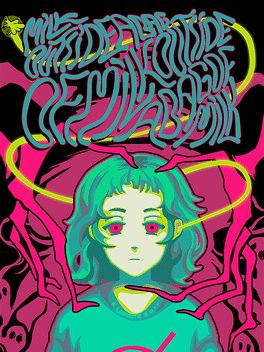(Originally published to Glitchwave on 4/24/2023)
[Image from igdb.com]
Milk Outside a Bag of Milk Outside a Bag of Milk
Developer: Nikita Kryukov
Publisher: Nikita Kryukov
Genre(s): Visual Novel
Platforms: PC, Switch
Release Date: December 16, 2021
Even though “Milk Outside” seems like a case of the developer releasing their game in its full form after exposing us to its beta test, “Milk Outside” does not fall under the hard reboot territory. “Milk Outside” is a sequel in the traditional sense of being set after the events of the previous title, with the disturbed girl from the first game returning home after completing her task of obtaining the bag of milk. The player is reminded of the events of the previous game immediately as they are showcased in the opening cutscene, displayed with full-fledged animation that must’ve blown a sizable chunk out of Kryukov’s budget. Once the game begins, the protagonist is victimized by a group of haunting shadows, spurred by her delusional thoughts that a corpse might be rotting away in her apartment. After one mental apparition closes, another one opens in the form of a blank-faced figure greeting her at the door who resembles the ghastly form of the archetypal “sleep paralysis demon.” The chilling figure sinks its icy claws into the protagonist as punishment for drinking milk, and the sensation of pain and discomfort the protagonist describes at this moment is quite graphic. I’m not sure what the significance of this creature is and why it’s insistent that the protagonist become lactose intolerant. However, what is clear to me from this introduction is that “Milk Outside” blazes over the previous game with a remarkable presentation. The animation is surprisingly refined and the contrasting black and red colors make the scene in the doorway truly terrifying.
Once the protagonist enters her room, the frantic atmosphere begins to wane and become tranquil like she’s arrived at her safe haven. It’s here where the player gets a clear view of the protagonist after receiving a few glimpses of her eyes in a hazy purple glow from “Milk Inside’s” point of reference. She’s a pale girl with messy brown hair, a baggy T-shirt, and an overall timid, haggard demeanor. Her overall wearisome presence is exactly what the player might’ve pictured her from the constant episodes of torment we’ve experienced with her. I think being able to see the protagonist from a third-person perspective here marks an evolution from the first game. Now that we’ve seen the level of dissonance she sees the world with, separating our view from hers can be essential to her growth and our better understanding of the character.
This shift is important because the player’s role is once again talking the protagonist through the events like her imaginary friend or omniscient, sentient presence that breaks the fourth wall. Before the protagonist can fall into her medication-induced sleep for the night, the player must help her collect six fireflies that have been scattered around her room. It’s here where the developer decides to gamify the visual novel foundation, with the protagonist overtly describing the objective as “being a character in a point-and-click adventure game.” Each object found in her room potentially houses one of the glowing insects, and the protagonist shares an anecdote about each item that gives her more personality. For some reason, the game will freeze if they select the vent, and the protagonist will insinuate that you’re trying to escape. For one, an air vent is a perfectly logical palace to look for bugs and secondly, is freezing the game with this selection a punishment from the game? I didn’t know I was playing fucking Minesweeper.
The game didn’t need more interactivity to spruce up the experience, but one thing that collecting the fireflies does is coincide with the ending. The player can choose to quit at any time, and the number of fireflies collected will determine the course. The ending is a dream sequence that occurs once the protagonist falls asleep, and her mind conjures up a plethora of possibilities. If the player collects all of the fireflies on their first playthrough, a younger version of the protagonist will escort a young boy through the process of purchasing milk from the same store seen in the first game, which also has its share of complications. Collecting all of the fireflies while skipping some of the cutscenes will see the protagonist’s face contorted at an assortment of unnatural angles. Half-assing the firefly collecting process will net endings that involve the protagonist descending a winding, never-ending staircase and failing to hold onto anything in a dark, expanding room. After each of these, the protagonist wakes in fright and bursts into tears. As traumatizing as they might be for the protagonist, the multiple endings were exactly what I wished “Milk Inside” would do with the variety of player options. I am absolutely satisfied.
Still, I feel like I don’t have a firm grasp on the substance of “Milk Outside” because so much has been put on my plate. Perhaps the malevolent figure at the beginning is a personified form of the protagonist's mother’s overbearingness and how it affected her personal development. Maybe the fireflies placing themselves on her personal items reflect how some things in her life still give her light and joy despite her condition. Every dream could represent a faction of her mental illness or display some unresolved trauma directly connected to it. It’s not a jumbled mess, but it takes some time to process the experience as a whole. Unlike “Milk Inside,” “Milk Outside” presents enough substance to make it worth pondering over.




No comments:
Post a Comment